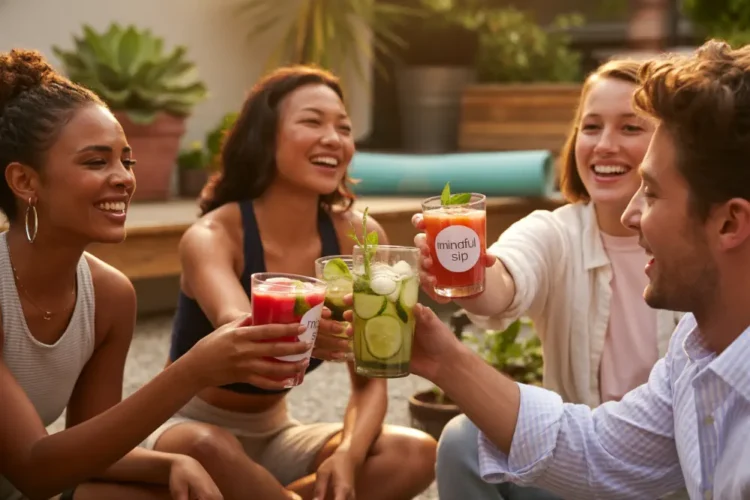Ready to make your summer events absolutely unforgettable? The beverage landscape has evolved dramatically in 2025, and smart event planners are already capitalizing on exciting new trends that are reshaping how we think about summer refreshments. Whether you’re planning an intimate backyard gathering or a large-scale corporate event, understanding these emerging trends could be the difference between a good party and a legendary one.
This year brings unprecedented innovation in summer beverages, driven by changing consumer preferences, technological advances, and a growing focus on sustainability. Industry experts report that summer beverage sales typically increase by 40-60% during peak months, making this the perfect time to implement trending options that will wow your guests and potentially boost your beverage revenue.
From AI-powered flavor combinations to ancient fermentation techniques making modern comebacks, 2025’s drink trends offer something for every taste preference and budget. We’ll explore practical implementation strategies, cost-effective alternatives, and insider tips from industry professionals who are already seeing remarkable success with these innovations.
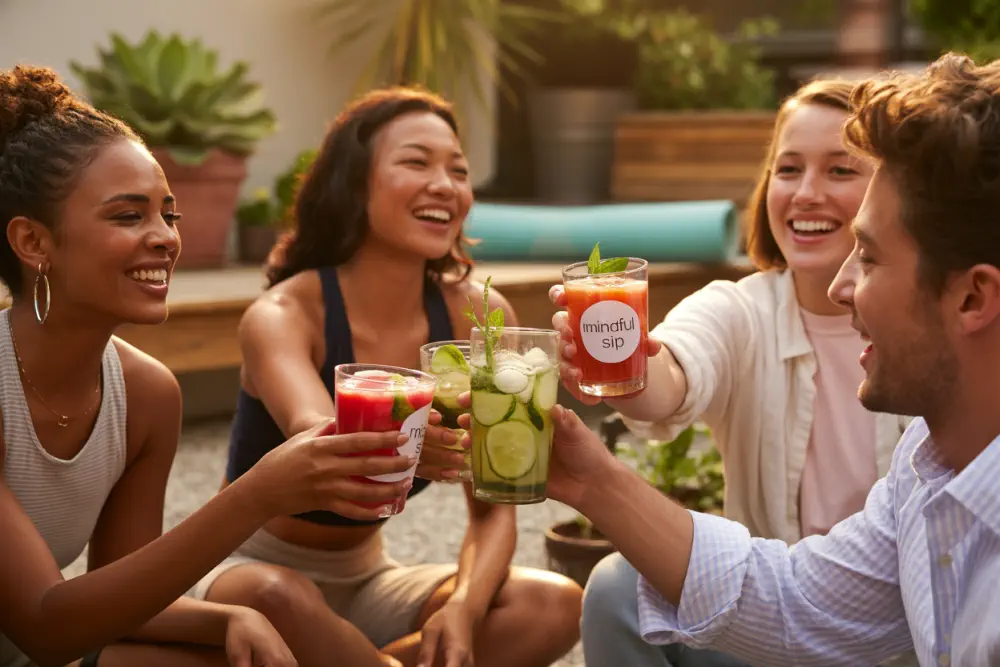
The Evolution of Summer Drinking Culture in 2025
Data-Driven Trend Analysis
The numbers don’t lie – summer drinking habits have shifted dramatically since 2020. Recent industry data shows that 79% of consumers actively seek refreshing cocktails during summer months, while 57% specifically prefer iced drinks over traditional room-temperature options. More telling is the 143% increase in mezcal sales between 2020 and 2023, signaling consumer willingness to embrace bold, adventurous flavors.
Generation Z is driving much of this change, with 38% purchasing more non-alcoholic beverages compared to just 8% of Baby Boomers. This demographic shift isn’t just about abstinence – it’s about mindful consumption and quality over quantity. When Gen Z does drink alcohol, they’re choosing premium options and expecting sophisticated flavor profiles that rival traditional cocktails.
The “zebra striping” phenomenon – alternating between alcoholic and non-alcoholic drinks throughout an event – has gained mainstream acceptance. This pattern allows guests to extend their social drinking experience while maintaining energy and avoiding overindulgence. Smart event planners are designing menus that seamlessly support this behavior.
Social Media’s Impact on Beverage Choices
Instagram and TikTok continue to shape drinking trends in unprecedented ways. Visual appeal now influences beverage selection as much as taste, with “Instagrammable” drinks generating 40% more engagement than standard presentations. The most successful trending drinks of 2024 shared common visual elements: vibrant colors, interesting textures, and photogenic garnishes.
TikTok’s influence extends beyond aesthetics to actual flavor preferences. Viral challenges featuring unexpected ingredient combinations have pushed mixologists to experiment with everything from pickle juice martinis to lavender-infused cold brew cocktails. These platforms have accelerated trend adoption from months to weeks, requiring event planners to stay agile in their beverage planning.
The most successful summer events now incorporate “shareability” into their drink design. This means considering lighting, backdrop options, and even providing branded hashtags that encourage social media documentation. Events featuring trending beverages see an average 25% increase in social media mentions, translating to valuable organic marketing.
Top 10 Summer Drink Trends Dominating 2025
Which 2025 Summer Drink Trend Should You Try First?
Functional and Health-Conscious Beverages
Adaptogenic Summer Drinks have moved from health food stores to mainstream event menus. These beverages incorporate herbs like ashwagandha, rhodiola, and holy basil, which are believed to help the body manage stress and maintain energy levels during hot weather. Popular combinations include watermelon-ashwagandha agua frescas and cucumber-rhodiola spritzers.
The key to successful adaptogenic drinks lies in balancing the often earthy, bitter flavors of these herbs with refreshing summer ingredients. Successful bartenders are using fruit-forward bases like pineapple and mango to mask any medicinal tastes while maintaining the functional benefits guests seek.
Probiotic Beverages are gaining traction as people become more aware of gut health’s connection to overall wellness. Kombucha-based cocktails and mocktails offer effervescence and complex flavors while providing beneficial bacteria. Popular variations include hibiscus-kombucha sangrias and ginger-turmeric fermented sodas.
These drinks require special handling and storage considerations, but their premium positioning allows for higher pricing that offsets additional costs. Guests appreciate both the health benefits and the sophisticated flavor profiles that fermentation creates.
The Sustainability Movement in Summer Drinks
Environmental consciousness is no longer optional – it’s expected. Zero-waste cocktail practices are becoming standard, with successful programs using every part of ingredients. Citrus peels become dehydrated garnishes, fruit pulp transforms into shrubs, and herb stems infuse syrups.
Local ingredient sourcing has evolved beyond simple farm-to-glass concepts. Event planners are partnering with urban farms, rooftop gardens, and even creating their own herb growing stations. This hyper-local approach reduces transportation costs, ensures peak freshness, and creates compelling storytelling opportunities for guests.
Plant-based milk alternatives in summer drinks have expanded far beyond almond and oat milk. Innovative options include pistachio milk in creamy cocktails, macadamia milk for tropical drinks, and even hemp milk for earthy, sophisticated flavors. These alternatives often provide better texture and foam stability than traditional dairy while appealing to diverse dietary preferences.
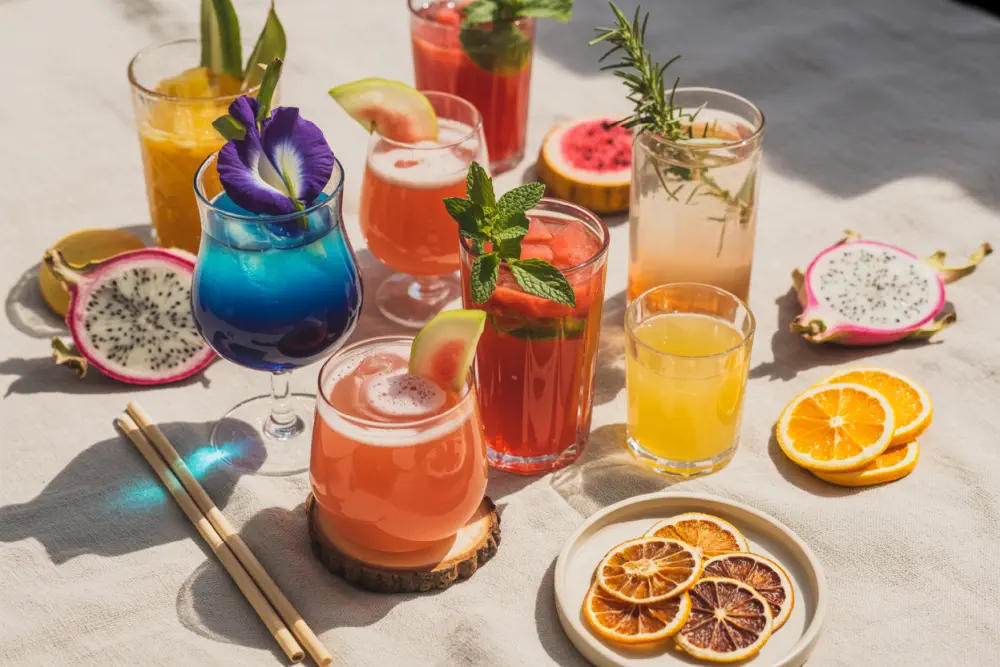
Global Fusion Flavors Taking Over
Asian-inspired beverages are dominating summer menus with ingredients like yuzu, lychee, and matcha creating refreshing alternatives to traditional citrus-based drinks. Korean influences include gochujang in spicy margaritas and soju-based cocktails that offer lower alcohol content with complex flavors.
Japanese influences extend beyond sake to include umami-rich ingredients like miso in coffee cocktails and seaweed in savory bloody marys. These ingredients require careful balance but create memorable flavor experiences that guests discuss long after events end.
Latin American tropical integration brings passion fruit, dragon fruit, and guava into mainstream summer beverages. Brazilian açaí bowls have inspired açaí-based smoothie cocktails, while Mexican agua frescas provide templates for naturally flavored, lightly sweetened drinks that appeal to health-conscious consumers.
Mediterranean influences include olive oil in cocktails (creating surprising richness), fresh herbs like rosemary and thyme, and seasonal cocktail pairings that complement outdoor dining experiences.
The Science Behind 2025’s Trending Flavors
Umami and Savory Cocktail Revolution
The fifth taste – umami – has finally found its place in beverage programs. Miso-based cocktails offer complex, slightly salty flavors that balance beautifully with citrus and fruit elements. A popular combination includes miso-washed whiskey with honey and lemon, creating depth that traditional sweet cocktails lack.
Seaweed and mushroom ingredients bring oceanic and earthy elements that pair surprisingly well with gin and vodka bases. These ingredients require careful measurement – too little provides no impact, while too much overwhelms other flavors. Successful implementations often use these ingredients in wash or infusion processes rather than direct addition.
Food-inspired cocktail development has moved beyond obvious combinations. Innovative bartenders are creating drinks that mirror popular dishes – think Caesar salad martinis with parmesan garnish or French onion soup-inspired cocktails with caramelized onion syrup.
Which 2025 Summer Drink Trend Are You Most Excited to Try?
Heat and Spice Integration
Global spice trends extend far beyond jalapeños and hot sauce. Sichuan peppercorns create a numbing sensation that’s surprisingly refreshing in summer heat, while sumac provides tart, lemony heat without overwhelming spiciness. Berbere spice blends from Ethiopian cuisine offer complex warmth that works beautifully in coffee-based cocktails.
Cooling spices like cardamom, fennel, and mint create interesting contrasts when combined with heat-generating ingredients. This balance allows for spicy drinks that don’t leave guests overheated – crucial for outdoor summer events.
Fermented spice applications, including fermented chili oils and spice pastes, provide depth and complexity while offering probiotic benefits. These ingredients require longer preparation times but create unique flavor profiles that can’t be replicated with fresh ingredients alone.
| Trending Spice Category | Popular Applications | Flavor Profile | Best Pairings |
|---|---|---|---|
| Asian Heat | Gochujang, Thai chili | Sweet-spicy, fermented | Citrus, tropical fruits |
| Middle Eastern | Sumac, za’atar | Tart, herbal | Gin, vodka bases |
| African | Berbere, harissa | Complex warmth | Coffee, chocolate notes |
| South American | Aji amarillo, chipotle | Smoky, fruity heat | Mezcal, tequila |
Low and No-Alcohol Movement Gaining Momentum
Sophisticated Mocktail Development
The days of overly sweet, simple mocktails are over. Advanced preparation techniques now create complex, layered flavors that rival alcoholic counterparts. Fat-washing techniques using coconut oil or nut butters create richness, while clarification processes produce crystal-clear drinks with intense flavors.
Premium non-alcoholic spirits have reached quality levels that fool even experienced drinkers. Brands like Seedlip, Lyre’s, and Monday Zero Alcohol offer botanical complexity that provides the sophistication today’s consumers expect. These products cost more than traditional mixers but allow premium pricing that maintains profit margins.
Presentation innovation for alcohol-free options has become crucial. Smoke effects, elaborate garnishes, and unique glassware ensure that choosing non-alcoholic doesn’t mean accepting a less impressive drink experience. Many successful programs use identical garnish and presentation techniques for both alcoholic and non-alcoholic versions.
The “Zebra Striping” Trend
This consumption pattern represents a fundamental shift in how people approach social drinking. Rather than choosing to drink or not drink, consumers are choosing when to drink alcohol throughout an event. Smart menu design supports this by offering equally appealing options in both categories.
Menu development for mindful drinking requires strategic placement and pricing. Non-alcoholic options should be prominently featured rather than hidden in separate sections. Pricing should reflect quality and preparation complexity rather than simply offering cheaper alternatives.
Social acceptance of choosing non-alcoholic options has reached a tipping point. Events that celebrate these choices rather than treating them as consolation prizes see higher guest satisfaction and more positive social media coverage.
Event Implementation Strategies for 2025 Trends
Summer Trend Implementation Cost Calculator
Menu Planning and Development
Successful trend implementation requires balancing innovation with familiarity. Industry experts recommend the 70-20-10 rule: 70% proven favorites, 20% emerging trends, and 10% experimental options. This balance allows for trend exploration while ensuring guest satisfaction.
Cost analysis becomes crucial when working with trending ingredients that often carry premium pricing. However, many trends actually reduce costs through local ingredient sourcing and waste reduction practices. Fermented ingredients, for example, extend shelf life while adding value.
Seasonal timing affects both ingredient availability and pricing. Planning menus around peak harvest times for trending ingredients can reduce costs by 30-50% while ensuring optimal quality. Urban farms and specialty suppliers often offer advance ordering programs that guarantee availability for planned events.
| Implementation Timeline | Activities | Cost Impact | Guest Experience |
|---|---|---|---|
| 6 months ahead | Ingredient sourcing, supplier relationships | Lowest costs, bulk ordering | Highest quality, peak flavors |
| 3 months ahead | Staff training, recipe development | Moderate costs | Good execution |
| 1 month ahead | Final menu confirmation, backup planning | Higher costs, limited options | Risk of substitutions |
| Week of event | Emergency sourcing, last-minute changes | Highest costs | Compromised quality |
Equipment and Setup Considerations
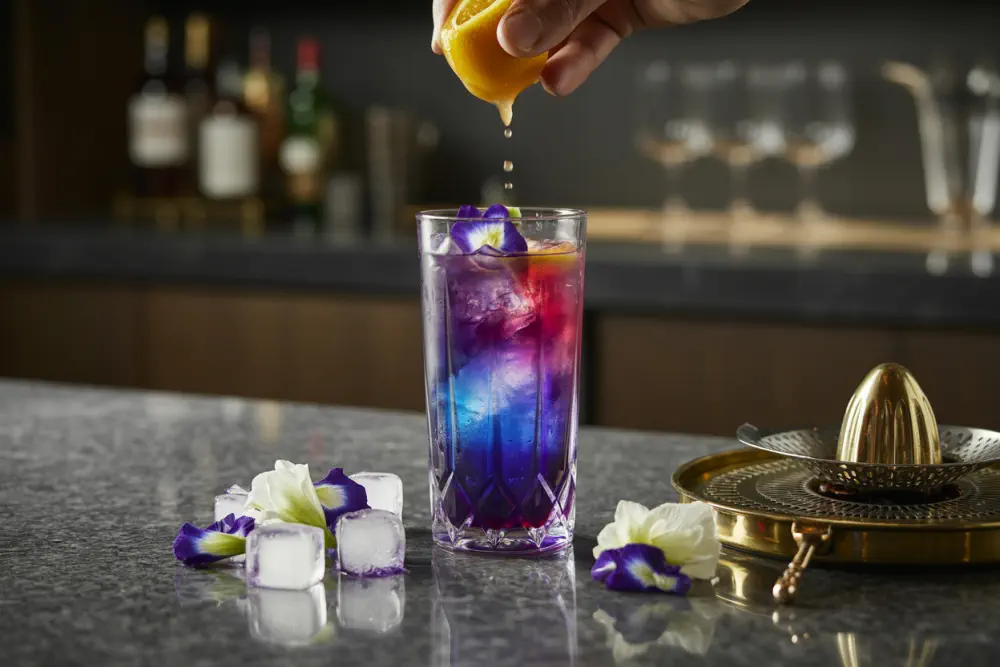
Technology integration enhances both efficiency and guest experience. Smart dispensing systems ensure consistent cocktail quality while reducing waste and over-pouring. These systems can store multiple cocktail recipes and adjust portions based on glass size or customer preferences.
Sustainable serving solutions include compostable straws, reusable glassware programs, and water stations that reduce single-use bottle waste. Many guests now specifically choose events based on environmental practices, making sustainability a competitive advantage.
Interactive beverage stations allow guests to customize drinks while reducing labor costs. Popular setups include build-your-own agua fresca bars, garnish selection stations, and DIY spritzer mixing areas. These setups work particularly well for trending ingredients that benefit from fresh preparation.
Staff Training and Knowledge Requirements
Trend education goes beyond simple recipe instruction. Staff need to understand the cultural significance of ingredients, proper pronunciation of international items, and the stories behind trending techniques. This knowledge enables authentic conversation with curious guests.
Customer education opportunities arise naturally when serving trending beverages. Staff training should include conversation starters about ingredient origins, preparation methods, and flavor profiles. Guests appreciate learning about their drinks, and education increases perceived value.
Safety considerations become important with new ingredients and techniques. Some trending spices can cause allergic reactions, fermented ingredients require temperature monitoring, and new equipment needs proper training to prevent accidents.
Visual Presentation and Experience Design
Color Psychology in Summer Beverage Presentation
Trending color palettes for 2025 emphasize natural, earth-toned hues alongside vibrant tropical colors. Dusty rose from hibiscus, deep purple from butterfly pea flower, and golden yellow from turmeric create sophisticated color stories that photograph beautifully while suggesting natural, healthy ingredients.
Color-changing cocktails using pH-sensitive ingredients like butterfly pea flower create memorable experiences and social media moments. These drinks change from blue to purple or pink when citrus is added, providing interactive entertainment that guests love to photograph and share.
Natural vs. artificial coloring choices significantly impact brand perception. [Natural coloring techniques](https://whaleycooks.com/drinks-ice-cubes-with a-twist/) using fruit juices, vegetable extracts, and spice infusions align with health trends while creating unique flavor profiles that artificial colors cannot provide.
Garnish and Decoration Innovation
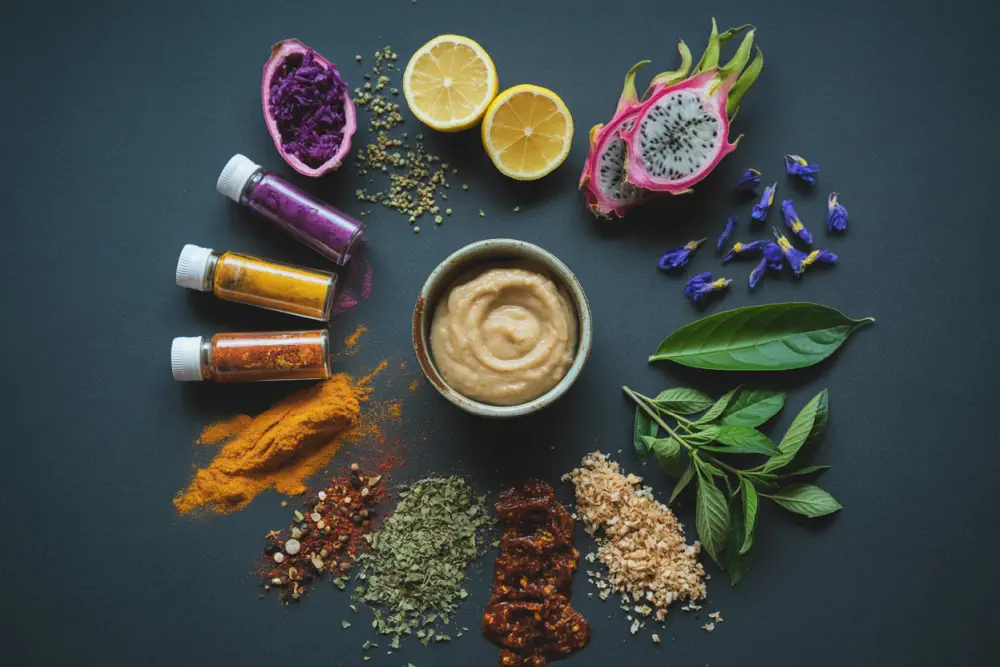
Edible flower integration extends beyond simple placement to incorporate flowers into flavor profiles. Lavender, rose petals, and hibiscus flowers provide aromatic elements that enhance the drinking experience. Proper sourcing ensures pesticide-free, food-safe flowers that add both beauty and flavor.
Herb integration has evolved from simple mint sprigs to complex herb bouquets that release aromatics as guests drink. Rosemary, thyme, and sage provide Mediterranean sophistication, while Asian herbs like shiso and Thai basil introduce international elements.
[Creative ice applications](https://whaleycooks.com/drinks-ice-cubes-with a-twist/) include fruit and herb-embedded ice cubes, flavored ice spheres, and even dry ice effects for dramatic presentation. These elements extend flavor release throughout the drinking experience while providing Instagram-worthy visual appeal.
Serving Vessel and Glassware Trends
Eco-friendly options include bamboo cups, recycled glass vessels, and compostable containers that align with sustainability trends. However, presentation quality remains crucial – eco-friendly doesn’t mean compromising visual appeal.
Instagram-worthy presentation techniques focus on height, layering, and unexpected vessel choices. Mason jars remain popular for their casual sophistication, while vintage glassware adds historical authenticity to classic cocktail revivals.
Cultural serving style influences bring international authenticity to global fusion trends. Japanese sake cups for Asian-inspired drinks, Mexican clay cups for agua frescas, and Moroccan tea glasses for Mediterranean flavors enhance the cultural storytelling aspect of trending beverages.
Seasonal Ingredient Spotlight for Summer 2025
2025 Summer Drink Trends Implementation Timeline
March – April
Adaptogenic beverages emerge
Perfect timing for spring wellness trendsMay – June
Savory cocktail revolution
Miso and seaweed combinations peakJuly – August
Peak summer implementations
All trends reach maximum adoptionEmerging Fruits and Botanicals
Dragon fruit provides striking visual appeal with its vibrant pink exterior and speckled white interior, while offering subtle, sweet flavors that pair well with citrus and mint. Its high water content makes it ideal for refreshing summer beverages.
Passion fruit delivers intense tropical flavor in small quantities, making it cost-effective for large events. Its natural acidity provides tartness that balances sweet elements without requiring additional citrus.
Garden-to-glass herb movements emphasize fresh, locally grown herbs that provide aromatic complexity. Basil varieties beyond sweet basil – including Thai basil, purple basil, and lemon basil – offer unique flavor profiles that distinguish trending drinks from standard offerings.
Fermentation and Preservation Techniques
Kombucha integration requires understanding fermentation timing and flavor development. Secondary fermentation with fruits and spices creates custom flavors while maintaining probiotic benefits. Popular combinations include ginger-turmeric for anti-inflammatory properties and berry blends for antioxidant content.
Shrubs and drinking vinegars provide shelf-stable flavor bases that combine sweet, sour, and often spicy elements. These concentrates store well and provide consistent flavors regardless of seasonal fruit availability.
Fermented fruit applications create complex flavors impossible to achieve with fresh ingredients alone. Fermented pineapple develops funky, wine-like notes that add sophistication to tropical drinks, while fermented berries provide depth to sangrias and spritzers.
Budget-Friendly Implementation Strategies
Trending Ingredient Compatibility Matrix
Quick Reference Guide:
DIY Trending Elements
Home preparation techniques allow for significant cost savings on trending ingredients. Simple syrup infusions with trending spices, herb oils for garnishes, and fermented fruit preparations can be made in advance at fraction of commercial costs.
Batch preparation strategies become crucial for events serving trending cocktails to large groups. Pre-made spice blends, infused spirits, and prepared garnishes ensure consistency while reducing per-drink preparation time.
Cost-effective ingredient substitutions maintain trending flavors without premium pricing. Local alternatives to expensive imported ingredients, seasonal substitutions for out-of-season fruits, and house-made versions of specialty products significantly reduce costs.
| Trending Element | Commercial Cost | DIY Alternative | Savings | Prep Time |
|---|---|---|---|---|
| Adaptogenic blend | $25/bottle | $5 homemade | 80% | 2 hours |
| Fermented syrup | $15/bottle | $3 homemade | 80% | 3 days |
| Specialty bitters | $20/bottle | $4 homemade | 80% | 1 week |
| Flavored ice cubes | $8/tray | $1 homemade | 87% | 4 hours |
Seasonal Menu Rotation Planning
Quarterly implementation schedules allow for gradual trend adoption while building staff expertise and customer familiarity. Spring testing of summer trends enables refinement before peak season demand.
Inventory management for trending ingredients requires understanding shelf life, storage requirements, and minimum order quantities. Many trending ingredients have shorter shelf lives than traditional options, requiring more frequent ordering and careful rotation.
Profit margin optimization focuses on pricing strategies that reflect both ingredient costs and perceived value. Trending drinks often command premium pricing due to novelty and sophistication, allowing for higher margins despite increased ingredient costs.
Regional and Cultural Influences on Summer Trends
Sustainability Impact Calculator
Carbon Footprint Reduction
Cost Savings
Sustainability Score
Personalized Recommendations:
- Increase local sourcing to reduce transportation emissions
- Implement composting for organic waste reduction
- Consider reusable glassware rental programs
International Inspiration Adaptation
Adapting global trends for local markets requires understanding both ingredient availability and cultural preferences. Asian-inspired drinks may need spice level adjustments for different regional palates, while tropical ingredients might require seasonal substitutions in colder climates.
Cultural sensitivity in beverage program development ensures authentic representation rather than superficial appropriation. Working with cultural consultants or community members provides authentic insight into traditional preparation methods and appropriate ingredient combinations.
Regional ingredient availability affects both cost and authenticity. Local alternatives to international ingredients often provide better freshness and lower costs while supporting local economies and reducing environmental impact.
Future-Proofing Your Summer Beverage Program
Trend Longevity Assessment

Identifying lasting vs. fad trends requires analyzing multiple factors: industry expert consensus, consumer behavior data, and alignment with broader cultural movements. Sustainability-focused trends show strong staying power, while purely aesthetic trends often fade quickly.
Investment priorities should favor equipment and training that support multiple trends rather than single-use items. Staff education in fundamental techniques enables adaptation to new trends without starting from scratch.
Monitoring and adaptation strategies include regular guest feedback collection, social media trend tracking, and industry publication review. Successful programs adjust quarterly rather than waiting for annual menu overhauls.
Seasonal Implementation Timeline
| Month | Preparation Activities | Featured Trends | Key Considerations |
|---|---|---|---|
| March | Supplier sourcing, staff training begins | Plan adaptogenic ingredient sourcing | Establish relationships with specialty suppliers |
| April | Recipe development, initial testing | Test global fusion flavors | Focus on ingredients with longer shelf life |
| May | Menu finalization, equipment setup | Launch sustainable practices | Barbecue event planning integration |
| June | Full implementation, staff certification | Peak umami cocktail season | Monitor guest feedback and adjust recipes |
| July | Menu optimization, cost analysis | Color-changing cocktails peak demand | Ensure adequate inventory for peak season |
| August | Seasonal ingredient transitions | Fermented beverage showcase | Plan for ingredient availability changes |
| September | Fall transition planning, trend evaluation | Assessment and planning for next year | Document successful implementations |
Expert Implementation Tips
Start Small and Scale Up: Successful trend adoption begins with testing one or two trends thoroughly rather than attempting to implement everything simultaneously. This approach allows for proper staff training and guest education while managing costs effectively.
Focus on Education: Both staff and guests benefit from understanding the stories behind trending ingredients. This knowledge transforms simple drink service into engaging experiences that justify premium pricing.
Quality Over Quantity: Better to execute three trends perfectly than seven trends poorly. Guests remember exceptional experiences more than extensive options.
Plan for Seasonality: Many 2025 trends rely on fresh, seasonal ingredients. Understanding peak availability and pricing cycles prevents cost overruns and ensures optimal quality.
Document Everything: Successful recipes, supplier contacts, cost breakdowns, and guest feedback create valuable resources for future events and menu development.
Troubleshooting Common Implementation Challenges
Challenge: High Ingredient Costs Solution: Partner with local suppliers for bulk ordering, implement proper inventory rotation, and consider making concentrated bases that extend expensive ingredients.
Challenge: Staff Resistance to New Techniques Solution: Provide comprehensive training with clear benefits explanation, start with volunteers who become trend ambassadors, and celebrate successful implementations.
Challenge: Guest Unfamiliarity with New Flavors Solution: Offer taste samples, provide ingredient education, and create familiar flavor bridges (like adding trending ingredients to classic cocktails).
Challenge: Inconsistent Execution Solution: Develop detailed recipe cards with precise measurements, implement quality checkpoints, and maintain regular staff refresher training.
Looking Ahead: Trends to Watch for Late 2025
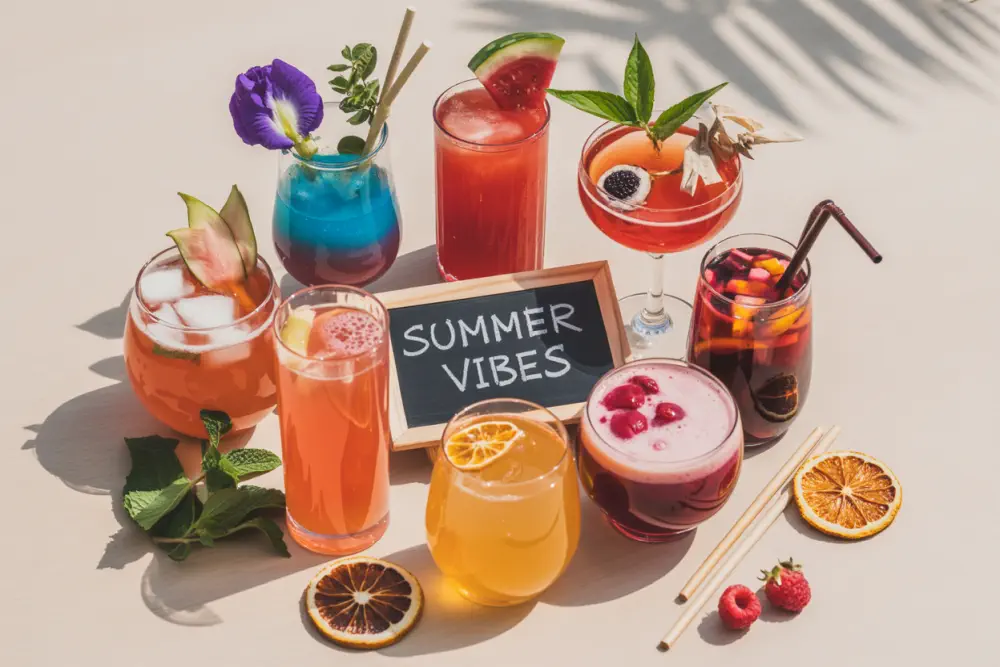
Several emerging trends show early promise for late summer and fall implementation. Mushroom-based beverages are gaining traction in wellness circles, offering earthy flavors and potential health benefits. CBD and THC integration continues expanding in legal markets, providing relaxation benefits without alcohol.
Fermented grain beverages inspired by traditional Asian preparations offer probiotic benefits with complex, slightly sour flavors that appeal to adventurous drinkers. These trends require longer development times but could provide competitive advantages for early adopters.
Climate-adapted ingredients reflect growing environmental awareness. As traditional growing regions shift due to climate change, beverage programs are experimenting with drought-resistant fruits and herbs that maintain flavor while requiring fewer resources.
Conclusion: Making 2025 Trends Work for Your Events
The summer drink trends of 2025 represent more than temporary fads – they reflect fundamental shifts in consumer values toward health consciousness, sustainability, and global cultural appreciation. Successful implementation requires strategic planning, quality execution, and genuine commitment to the values these trends represent.
Key takeaways for immediate action:
• Start with one trend that aligns with your event style and budget, implementing it thoroughly before expanding • Invest in staff education to ensure authentic presentation and guest engagement • Focus on quality ingredients and sustainable practices that justify premium pricing • Document successful implementations for future events and continuous improvement • Monitor guest feedback and adjust offerings based on actual preferences rather than assumptions
The beverage landscape continues evolving rapidly, but events that thoughtfully implement trending elements while maintaining excellent execution consistently outperform those that either ignore trends completely or implement them poorly. Understanding hydration benefits alongside trending flavors ensures guest satisfaction throughout your event.
Whether you choose to explore the science of flavor through umami cocktails or embrace sustainability through zero-waste practices, the key lies in authentic implementation that enhances rather than complicates the guest experience.
Success in 2025’s beverage trends comes not from following every innovation, but from selecting trends that genuinely improve your events while reflecting your values and meeting your guests’ evolving expectations.
Frequently Asked Questions
Q: Which summer drink trends offer the best return on investment for small events? A: Adaptogenic beverages and sophisticated mocktails provide excellent ROI for smaller events. They use cost-effective base ingredients, command premium pricing, and appeal to health-conscious guests. Start with simple adaptogenic agua frescas using local fruits and basic adaptogens like ashwagandha.
Q: How can I implement trending ingredients without overwhelming traditional guests? A: Use the “bridge technique” – incorporate trending ingredients into familiar cocktails. For example, add a small amount of miso to an Old Fashioned or use butterfly pea flower in a classic gin and tonic for color-changing effects. This approach introduces new flavors gradually.
Q: What equipment investments are most important for 2025 drink trends? A: Focus on versatile equipment that supports multiple trends: high-quality muddlers for fresh ingredient preparation, precision measuring tools for complex flavor balancing, and proper storage solutions for fermented ingredients. Avoid single-use gadgets until you’ve established successful trend implementation.
Q: How do I source specialty ingredients for trending cocktails? A: Build relationships with specialty food distributors, Asian markets for international ingredients, and local health food stores for adaptogens. Many suppliers offer bulk ordering discounts and can recommend substitutions when specific ingredients are unavailable.
Q: Can trending drinks be prepared in advance for large events? A: Many trending elements can be batch-prepared: infused syrups, adaptogenic base mixtures, and fermented components store well. However, fresh elements like herbs and certain color-changing reactions work best when added just before serving. Plan a hybrid approach for efficiency.
Q: How do I price trending cocktails appropriately? A: Consider ingredient costs, preparation complexity, and perceived value. Trending drinks typically command 15-30% premium over standard cocktails due to novelty and quality ingredients. However, ensure pricing reflects actual value provided rather than simply charging more for trends.
Q: What’s the best way to train staff on new trending ingredients and techniques? A: Implement progressive training starting with basic ingredient knowledge, followed by preparation techniques, and finally guest education talking points. Create laminated reference cards with pronunciation guides, flavor profiles, and origin stories for complex ingredients.

